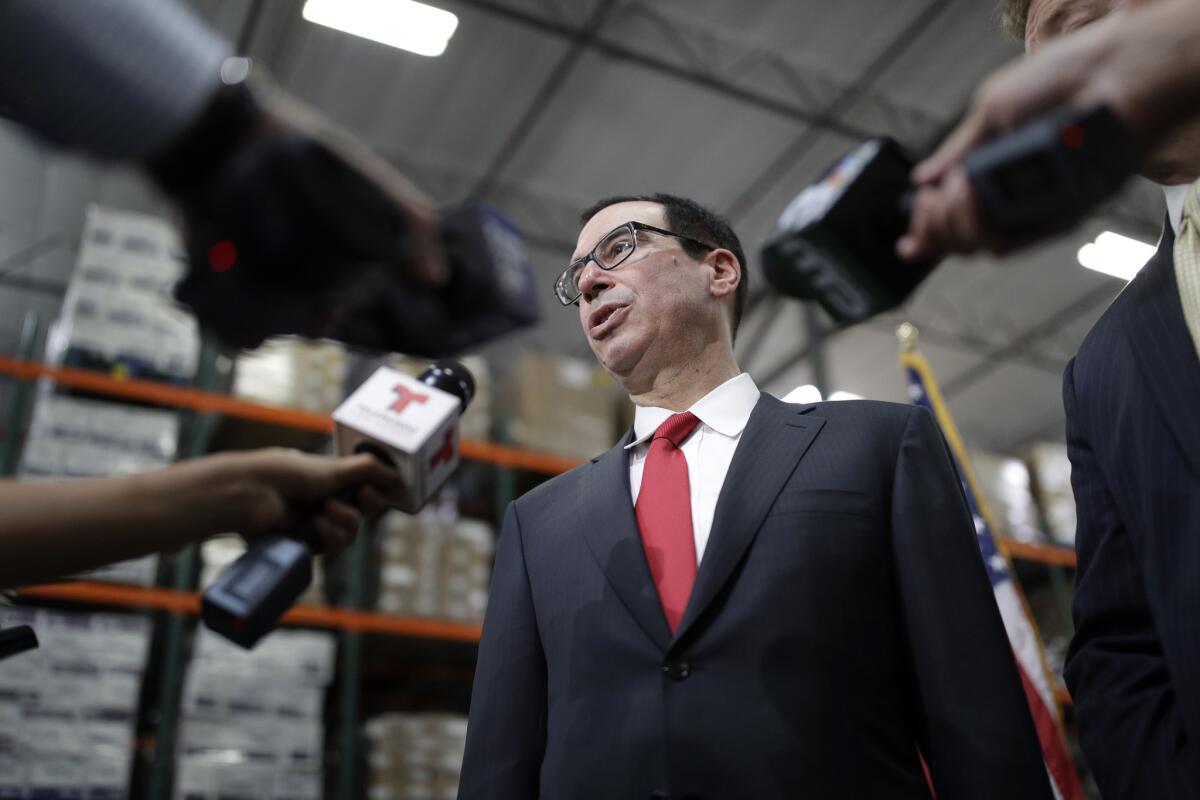Column: With the debt ceiling fight, Congress and Trump are playing with fire -- again

- Share via
People who get a kick out of watching children at play must love the spectacle staged in Washington every time the issue of the federal debt ceiling comes up. But they’re the only ones.
For most responsible onlookers, the spectacle is nerve-racking. Taxpayers face higher government costs and suspended programs. People who provide services to the government for pay, including public employees, get stiffed. Investors fret over the possibility that a federal default on its debt will produce a surge in interest rates and a stock market crash and a long-term crisis of confidence in the safety of U.S. government securities. Economists worry about potentially cataclysmic effects on global financial systems.
Most politicians wish, in their hearts, that the debt ceiling would just go away. Yet it’s still with us, despite universal judgment that it’s useless and a perennial waste of everyone’s time. Even President Trump, displaying shockingly wise economic judgment, has dissed the debt ceiling. “For many years people have been talking about getting rid of the debt ceiling altogether,” he said in June 2017. “There are lots of good reasons to do that.”
For many years people have been talking about getting rid of the debt ceiling altogether. There are lots of good reasons to do that.
— President Trump, 2017
Trump hasn’t repeated that sentiment since then, as far as we can tell. That’s too bad, because the debt ceiling is back. After a suspension of roughly 13 months enacted as part of a bipartisan budget bill in February 2018, the debt ceiling went back into effect on March 9, at the level of government debt in the marketplace at that moment -- $22 trillion. In other words, the government instantly hit the ceiling.
Since then, the Treasury has kept the government going through what are known as temporary “extraordinary measures,” and what managers of household budgets know as “moving money around.” These include deferring payments to government funds that would otherwise require issuing government debt, thus leaving some borrowing headroom for other purposes. The funds include the government employee retirement fund and a Thrift Savings Plan investment fund, which holds retirement investments made by government workers. The funds will be made whole once the debt ceiling crisis passes, but at a cost to taxpayers that could run into the hundreds of millions of dollars.
Every couple of years, with a regularity you can almost set your watch by, Congress flirts with the threat of not raising the federal debt ceiling and toying with a federal default.
The extraordinary measures can work only for a short period, after which they run out. By the Treasury’s current reckoning, that point comes in mid-September. In other words, that’s the drop-dead date for raising the debt ceiling. Adding to nervousness about the date is that it’s been creeping closer. The Treasury originally said it would have enough options to keep the debt ceiling from being breached until November. Then it revised its projection to the end of October, and again to September. The changes result chiefly from shortfalls in government tax collections because of the tax cut bill Republicans enacted in December 2017 on the promise that it would pay for itself. It hasn’t.
Let’s be clear that the consequences of breaching the debt ceiling would be dire. If the government defaults on its bonds by missing a payment, its cost of borrowing would instantly rise, placing a further burden on the budget and cratering the value of Treasury securities held by individuals, pension funds and sovereign nations. The safe-haven stature of T-bonds and the dollar would be deeply impaired. Interest rates would rise for all forms of debt — mortgages, credit cards, state and local borrowing. Government output of Social Security checks, tax refunds, Medicare reimbursements, military salaries and more would be reduced or halted.

Before we get into the substance of the current discussions, which involve House Speaker Nancy Pelosi (D-San Francisco) and Treasury Secretary Steven T. Mnuchin, let’s canter through the historical background of this stupid government rule.
As we’ve reported many times before, the debt ceiling originally was enacted to give the Treasury more freedom to issue debt, not less. That was in 1917. At that time, Congress was required to vote on every bond issue, which the members rightly considered a pain in the rear. They decided that it would be better to give Treasury blanket authority to issue bonds, but not unlimited authority. So it imposed an aggregate limit.
President Trump appears to have signed on to a very good idea: scrapping the debt ceiling.
By the 1960s, the limit became a hindrance to fiscal policy. Raising it turned into a routine. Since 1962, Congress has raised the limit roughly 100 times, on average more than once a year. More recently, unfortunately, the debt ceiling acquired the image of a brake on fiscal irresponsibility on Capitol Hill, the idea being that if the government was forbidden to borrow, it would have to live within its means. This was a gift to tea party types and other conservatives whose goal was to shrink federal programs (typically, those that served the working class and the poor). They could proclaim themselves guardians of public resources, with the debt ceiling serving as their line in the sand.
This was always mere posturing. Spending decisions are made by Congress, almost always without regard to the debt ceiling, which comes into play later, when the Treasury is tasked with finding the money for congressional mandates. The Government Accountability Office delivered a reality dose about this as bluntly as possible in a report in February 2011: “The debt limit does not control or limit the ability of the federal government to run deficits or incur obligations,” the agency wrote. “Rather, it is a limit on the ability to pay obligations already incurred.” (Politicians who never stop jabbering about the need for individuals to accept “personal responsibility” for their finances always seem to forget that when the topic turns to the need for government to make good on its borrowing.)

The government has always managed to avoid default, but sometimes it has been a close call. In 2011 Congress passed an increase only hours before the ultimate deadline, averting default but prompting Standard and Poor’s to downgrade the creditworthiness of U.S. government debt for the first time ever. In 2013 the ceiling was raised with a day to spare, in 2017 weeks and in 2018 a month (producing the suspension that expired on March 9).
Serious economic policy thinkers aren’t comforted by this sort of brinkmanship. In 2003, when the debt limit kicked in for three months, the government had to call in bonds held by a civil service retirement fund early, costing the fund and its members more than $1 billion in lost interest. Former Reagan economic advisor Bruce Bartlett accurately called the debt ceiling fight (in 2009) a “uniquely American political crisis” with its roots in “political theater.” The danger always is that the children in whose hands this weapon rests can’t be trusted to understand its potency. In 2010, for instance, a Republican congressman from South Carolina airily dismissed concerns about the consequences of a default on U.S. government debt: “I have heard people say that if we don’t do it it will be the end of the world,” he said then. “I have yet to meet someone who can articulate the negative consequences.”
That was Mick Mulvaney, who is now director of the Office of Management and Budget.
Fortunately, Treasury Secretary Mnuchin, like all his predecessors, is fully alive to the negative consequences. He has been urging action on the debt ceiling since the spring. But progress has been stalled by discord on broader budget issues. On Monday, Pelosi turned down his proposal for a short-term rise in the debt ceiling to be enacted next week, before Congress leaves for its summer recess. Pelosi and her House Democratic caucus want an agreement that protects nonmilitary spending from cuts, which the Trump White House so far has refused to accept.
Pelosi isn’t asking enough. She should demand abolition of the debt ceiling as the price of lifting it now. Almost every deal to raise the debt ceiling in recent years has produced bad policy one way or another. The consequences of breaching the ceiling are just too serious for this weapon to remain in partisan arsenals — on either side of the aisle. It does nothing but get in the way of intelligent fiscal management. Get rid of it, already.
More to Read
Inside the business of entertainment
The Wide Shot brings you news, analysis and insights on everything from streaming wars to production — and what it all means for the future.
You may occasionally receive promotional content from the Los Angeles Times.












